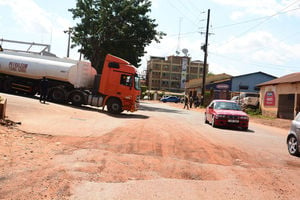
A section of the Nyendo-Cathedral road with deep potholes and no drainage system. If you regularly drive on rough roads, it is recommended to check your wheel alignment after every 1,000km. PHOTO BY ALI MAMBULE
For any motorist, it is important to understand that preparing your car for bad road conditions is a tough job. This is because there are conditions that manufacturers put into consideration when manufacturing vehicles, including those to be used off-road, where the vehicle is going and the road condition is not the same as what you would expect under normal road circumstances.
According to stearnscompanies.com, dangerous driving conditions can vary, depending on the location and nature of the conditions. In some cases, it may be due to poorly maintained roads, while in others, it may be because of bad weather conditions or even the nature of the slope. Drivers need to be aware of their surroundings and plan their routes accordingly.
The right tyres
David Nyoike, the service manager at Nissan Motorcare, says tyres provide traction and stability while driving. As such, it is important to make sure that they are in good condition.
For example, some tyres are 40 percent meant for off-road and 60 percent for tarmac use. Depending on your usage and the terrain you drive on, you can adjust the vehicle’s ratio to suit the roads you frequently use.
“The right tyres to use go hand in hand with tyre pressure. If you are driving in extremely dusty conditions, you need to have your air filters or cleaners regularly checked so that you do not have blockage that could lead to expensive repairs with turbos or even increased fuel consumption. After every trip, have your air filter checked by your mechanic to make sure it is not blocked, which allows for better air intake management,” Nyoike advises, adding that as a precaution, one must also always drive with a spare tyre in their car.
Type of rims
Low profile rims and tyres are the biggest victims of bad road conditions. There is also the aspect of low and high profile rims. Low-profile rims and tyres add nothing but beauty to the car regardless of whether they are saloons, SUVs, sedans or pick-up trucks. Unfortunately, low profile rims and tyres are not friendly and compatible with the nature of our roads. At the time of determining and deciding the type of tyres to use is the best time you also need to carefully consider the type of rims to use.
“When you have low profile rims, it means you will have low profile tyres. Unfortunately, this also means your car will not be able to drive safely through potholes. If you drive on low-profile rims and tyres, you have to avoid potholes. If you are to drive on low-profile rims and tyres, you must be very keen on your driving speed as well,” Nyoike adds.
Suspension system
When it comes to the suspension system, there is nothing much you can do other than make sure it is regularly checked, especially the suspension bushes. Bushes in the long run push the tyres out of proper wheel alignment if they are not in good condition. If you regularly drive on rough roads, it is recommended to check your wheel alignment after every 1,000km.
In the process, the suspension bushes and ball joints will also be checked either for repair or replacement.
Damage to key parts
Certain car parts such as the oil sump are located underneath the car. Most sumps are made of steel or aluminium and are sometimes exposed to damage while driving on rough roads.
The design and positioning of the sump is in such a way that it will always be above the cross member. By the time you hit it, you have damaged much more. The cross member is at the front, where the steering rack is mounted. Part of the engine, depending on different car brands, could also be mounted on the cross member.
“Nothing much will protect your vehicle from hitting a rock. Most cars offer limited protection, primarily through the opportunity for modifications. These changes allow owners to enhance safety features and adapt their vehicles to better meet their needs. The oil sump is always above the gearbox level and there will be much more you will have damaged by the time you get to the sump,” says Robert Agaba, a mechanic.
Bumpers
It is important to remember that when driving on rough roads, the bumpers are the most vulnerable parts of your vehicle. The exception is raised pick-up trucks, whose bumpers are less exposed to potential damage, providing an advantage in challenging terrain.
When driving a sedan, if you accidentally drive into a ditch, your bumper will likely scrape against the road as you attempt to drive out. This is why you should be mindful of your approach angle when navigating potholes. Taking the time to assess the terrain can help prevent damage.
Speed limits, right of way
According to stearnscompanies.com, speed limits exist for a reason and should always be followed. They are in place to help keep drivers safe by ensuring that they are driving at a safe speed.
This is especially important when driving on dangerous roads where a simple mistake may lead to a nasty situation. Sticking to the speed limit improves your chances of arriving at your destination safely, especially in poor weather.
When driving on dangerous roads, it is important to yield to the right of way. This is especially true when you encounter emergency vehicles and pedestrians. By yielding to the right of ways, you can help keep everyone safe. So, make sure to always yield when necessary and work on your defensive driving techniques.
With all the above factors in mind, you have to be mindful of the road and your driving speed since it determines how you drive over potholes. This, in the long run, determines the impact or extent of damage you expose your vehicle to.
SAFETY
Why you must practice defensive driving
Defensive driving is especially important on dangerous roads.
It means being aware of other drivers around you and anticipating their actions. If someone is driving erratically, give them a wide berth and do not engage in any aggressive behaviour yourself. By remaining calm and focused, you can avoid escalation and maintain control of the situation through defensive driving. Driving defensively can also mean driving slower if you need to, such as in poor weather conditions or poorly paved roads, to avoid getting into an accident.




